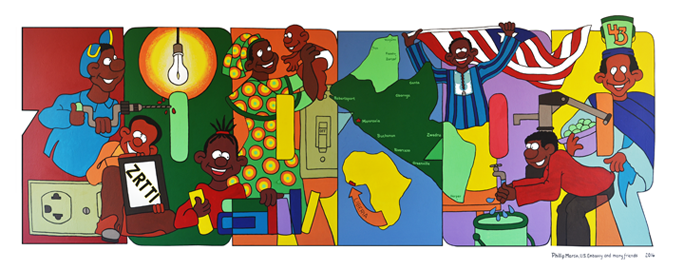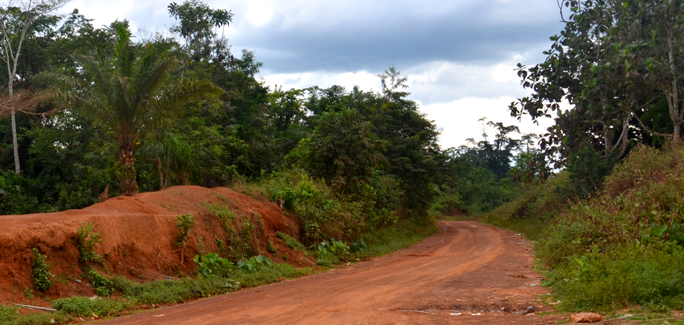| ... |
|
||||
|
MARTIN
|
|||||
 |
|||||
|
Click here to see larger image.
|
|||||
|
Story
of the Mural 43 in Zorzor, Liberia
|
|||||
|
Cha
– Cha – Cha – Changes. Just like the
song, I stutter – and shudder - even saying the word. Same
old, same old is just so much easier to handle. It’s even
one less syllable! But, like it or not, life is full of cha –
cha – cha – changes. It’s inevitable!
And, there were certainly a lot of those cha – cha – cha
– changes from the moment I arrived in Liberia. Cha
– cha – cha – change number one happened before
entering the airport. Ebola is still fresh on the minds of Liberian
health workers, government officials and citizens. Before entering
public buildings (like the airport), everyone needed to first wash their
hands. Towels and soap might have been a nice touch. It
didn’t happen, but I entered Liberia with clean hands –
until I put them in my pockets to dry them off. Same
Old, Same Old. Getting my luggage in the baggage claim
area was closer to the old nightmare. The room was entirely too
small. People were lined up three to five bodies deep. Even
though I saw my luggage going around, it was a struggle to break through
the crowd and pull out my trusty old Goodwill suitcase. Hmmm .
. . possibly I’d be flexible enough to not mind a cha –
cha – cha – change at the airport? CHA
– CHA – CHA – CHANGES! I didn’t
recognize Monrovia. It was like visiting the place for the first
time – including my old stomping grounds around the Peace Corps
Office in the Sinkor neighborhood. I heard one American describe
Sinkor as the “new restaurant neighborhood”. There
was no restaurant neighborhood in my Liberia! And, my experience
certainly included no staying at hotels that knew what an official U.S.
stipend was. Actually, I don’t think I ever stayed in a
hotel in Liberia. This time, it was too much to mention without
embarrassment and I certainly didn’t get what I paid for.
Same
Old, Same Old. Before going up country, it was standard
operating procedure to go to the grocery store to gather up supplies
that just couldn’t be found on site. My list wasn’t
all that big. I usually looked for cocoa powder for no-bake cookies
and chocolate cake. So, before going to Zorzor, I washed my hands
and went into the grocery store. My guide said there was almost
nothing available in Zorzor. I didn’t fully believe him
until I actually arrived in town. He was right. Shopping
was so very limited. I’m very thankful I stocked up on oatmeal,
some kind of margarine substitute (that mysteriously didn’t seem
to melt in the heat), bread, peanut butter and bottled water.
Cha
– cha – cha – changes. The road from
Monrovia to Gbarnga was always fairly nice. There were bumps along
the way. On my very first trip into the interior, we hit one bump
and the door of the van fell off. I was so thankful not to be
seated by that missing door. The road was recently worked on by
the Chinese, and a lot of it was simply fantastic. But, almost
the entire way to Gbarnga (about 100 miles), I noticed that there was
no longer any brush growing right up next to the edge of the road.
I thought about that brush for a very specific reason. |
|||||
 |
|||||
|
Looking
to the left and right in a time of need.......
|
|||||
|
In my African
experience, everybody talked about diarrhea. Everybody had it
at one time or another. Really, a whole lot more than one time!
We talk about the colors, smells, texture, cramps and threw around names
like shigella and giardia. Nobody back home ever talks about these
kind of things. But, in Africa, diarrhea is your friend.
If you don’t want to go to some function, just tell people you
have diarrhea. Everybody understands the problem. Nobody
will ever blame you for not attending. Of course,
if you talk about diarrhea, you’re also going to have mishaps
to share. I had a massive attack of cramps one time while
seated in the back of a crowded van on the way to Gbarnga. And,
this is why I remember the brush along the roadside so clearly.
I didn’t want to disturb the rest of the people in the van.
But, if immediate action wasn’t taken, there was going to be a
smell in the van that would disturb everyone a whole lot longer.
Another volunteer called out to the driver and said he needed to stop
right away. I stumbled out of the van, eternally grateful to find
bushes right up next to the road. It’s one thing to have
a dire diarrhea story when everyone in the van knows exactly what’s
happening. It would have been a whole other level of embarrassment
if there hadn’t been bushes around to hide my shame and other
things. Same Old. Same Old. When I rode in from the airport, I heard some Americans talking about restaurants, and where to get the best sushi, and what was overpriced. Yadda … yadda … yadda. I wouldn’t have the same African experience as those people. I wanted to eat a local cook shops and enjoy Liberian food. We stopped for lunch in Gbarnga. We didn’t have the cassava leaves that I especially wanted. There was no beans gravy, palm butter or jollof rice. But, the dish certainly had the hot pepper that I remembered. That pepper used to make me cry every time I ate. Other people, well, let’s just say they would keep their eyes open in search of brush along the roadside. Fortunately, the road after Gbarnga was not paved. There was all kind of brush along the road if nature ever called my name. Even more fortunately, nature never called and I arrived at the Zorzor Rural Teacher Training Institute safe, smiling and with nothing even close to a cramp. Usually,
I get the theme for my murals by talking to some kind of administrators.
That didn’t happen in Zorzor. Any and all authority figures
abandoned me as I met with the dozen or so painters I was to work
with. I had no idea what kind of theme they’d come up
with. I was very pleasantly surprised. Their concerns for their
community could be summed up in three categories. All of which
are considered pretty much basics back home, but not in Zorzor.
So, this
was the information that was woven into the mural design. The
concepts were illustrated inside the letters that spelled Zorzor.
However, those letters aren’t obvious. You will need to
study the design a while to find the spelling. I enjoy
the mural experience all over the planet, but Africa is always special
to me. The day started with an African twist. Paint needed
to be shaken. I gave the cans to my crew and asked my artists to shake
them with an African dance. I wish I could move the way they did.
And, they didn’t need any music to bust a groove. But later
in the day, there was also music. I only remember one song in
English, but it couldn’t have been a more perfect time to hear
“We Are the World”. The mural in Zorzor was faster and smoother than most projects. And, there was a very good reason for this. Zorzor had two professional sign painters in the town. Both of them helped on the project. I passed jobs along to them like gradual blending around the light bulb, the African shirt design, details on an unknown group of vegetables and even some outlining. I almost never find anyone who can outline to my satisfaction. It sort of makes me the indispensable artist. However, I wasn’t as indispensable on this project. The extra help in Zorzor gave me a little extra time to explore my African environment. |
|||||
| MARTIN | |||||
| Copyright 2016 by Phillip Martin All rights reserved. | |||||